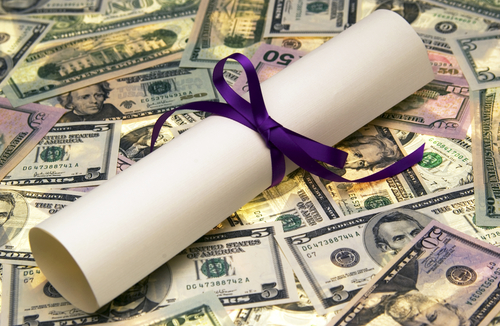The crunch in the economy just a few years ago put a lot of people out of work. It also prevented many new college graduates from getting jobs quickly. This caused many people to either want more college training, or retraining in the case of older people. When put together, the number of new student loans since 2010 is now threatening to push the overall student loan debt to over $1 trillion for the first time this year, reports the New York Times.
Although the figure may not be exact, it is derived by Mark Kantrowitz, and it is published at the FinAid.org website. On his website, Mark has a student loan debt clock where it gains about $2,854 every second. The clock started out at an estimated $830 billion in education loans from both the government and private sectors. It also takes into consideration new loans and repayments.
The amount of student loan debt is now greater than the debt owed on credit cards, says the Federal Reserve Board. Students have taken out loans just in 2010 alone that are equal to $100 billion, and this is the first time this number has been reached.
Student loan debt is treated differently than a lot of other debt when it comes to not paying it off. While a lot of debt can be written off, such as a mortgage or credit card debt, the courts decided in 2005 that student loans cannot simply be wiped clean. The money has to be repaid – it cannot even be discharged through a bankruptcy. Currently, about 15 percent of the people in the United States have some kind of student loan, which comes to about 37 million people.
The latest data from the US Department of education on student loan default rates show that it is at 8.8 percent, as of 2009. In 2005, just four years earlier, it was only 4.6 percent. This figure is broken down further into the default rates at different types of schools. Public institutions have a default rate of six percent; private institutions have a rate of four percent, but for-profit schools have a default rate as high as 11.6 percent.
These figures clearly show that a poor economy has affected the ability of people to pay off their student loans. The numbers do not show how many people have defaulted after making payments for more than two years. In the two years prior to these statistics, there were about 3.4 million borrowers who were required to start making payments on their loans, but more than 238,000 of them defaulted.
For those who are having difficulty repaying their student loan debt, there may be some options, as outlined by the Department of Education website. One of these is to get reasonable payment amounts that you can afford. Other options include repaying the loan in full, or consolidating your student loans and getting lower payments. If you do nothing, however, you can be sure that it will hurt your credit score and that action will be taken against you through collection agencies or through garnishing of your wages.
The crunch in the economy just a few years ago put a lot of people out of work. It also prevented many new college graduates from getting jobs quickly. This caused many people to either want more college training, or retraining in the case of older people. When put together, the number of new student loans since 2010 is now threatening to push the overall student loan debt to over $1 trillion for the first time this year, reports the New York Times.
Although the figure may not be exact, it is derived by Mark Kantrowitz, and it is published at the FinAid.org website. On his website, Mark has a student loan debt clock where it gains about $2,854 every second. The clock started out at an estimated $830 billion in education loans from both the government and private sectors. It also takes into consideration new loans and repayments.
The amount of student loan debt is now greater than the debt owed on credit cards, says the Federal Reserve Board. Students have taken out loans just in 2010 alone that are equal to $100 billion, and this is the first time this number has been reached.
Student loan debt is treated differently than a lot of other debt when it comes to not paying it off. While a lot of debt can be written off, such as a mortgage or credit card debt, the courts decided in 2005 that student loans cannot simply be wiped clean. The money has to be repaid – it cannot even be discharged through a bankruptcy. Currently, about 15 percent of the people in the United States have some kind of student loan, which comes to about 37 million people.
The latest data from the US Department of education on student loan default rates show that it is at 8.8 percent, as of 2009. In 2005, just four years earlier, it was only 4.6 percent. This figure is broken down further into the default rates at different types of schools. Public institutions have a default rate of six percent; private institutions have a rate of four percent, but for-profit schools have a default rate as high as 11.6 percent.
These figures clearly show that a poor economy has affected the ability of people to pay off their student loans. The numbers do not show how many people have defaulted after making payments for more than two years. In the two years prior to these statistics, there were about 3.4 million borrowers who were required to start making payments on their loans, but more than 238,000 of them defaulted.
For those who are having difficulty repaying their student loan debt, there may be some options, as outlined by the Department of Education website. One of these is to get reasonable payment amounts that you can afford. Other options include repaying the loan in full, or consolidating your student loans and getting lower payments. If you do nothing, however, you can be sure that it will hurt your credit score and that action will be taken against you through collection agencies or through garnishing of your wages.







